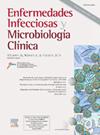Neonatal sepsis: Epidemiology and comparison between preterm and term newborns
IF 2.5
4区 医学
Q3 INFECTIOUS DISEASES
Enfermedades infecciosas y microbiologia clinica
Pub Date : 2025-04-01
DOI:10.1016/j.eimc.2024.07.010
引用次数: 0
Abstract
Introduction
Neonatal sepsis is a severe clinical syndrome that continues to be a common and significant health care burden. Knowledge of the local epidemiology allows for a better empirical treatment and improves morbidity and mortality. The aim of this study was to determine the prevalence, epidemiology, and etiology of blood culture-proven sepsis in neonates and to determine whether there are differences between preterm and term newborns.
Methods
A retrospective study was carried out in a tertiary hospital in Madrid, Spain, during 2021, including 1443 patients at risk of developing sepsis.
Results
The majority of sepsis episodes occurred in preterm newborns (64.81%) and most of them were very low birth weight infants (74.29%). Late-onset sepsis represented 94.92% of all the episodes reported with an incidence of 11.4 (95% CI 8.8–14.8) per 1000 live newborns. Early onset sepsis incidence was 0.6 (95% CI 0.2–1.8) per 1000 live newborns. Coagulase-negative staphylococci took the first place as causative agents of sepsis (66.10%), causing in all the episodes late onset catheter-related bloodstream infection. When the newborns who developed sepsis were compared with those who did not developed sepsis, the presence of venous/arterial access device was significantly associated with sepsis in both preterm (odds ratio (OR) 8.12, 95% CI 0.47–141.40) and term newborns (OR 16.58, 95% CI 1.00–275.20). Recent surgery was nevertheless the main risk factor in term newborns (OR 45.29, 95% CI 13.70–149.70). Among those patients who developed sepsis, no differences between preterm and term newborns were found regarding time onset, mechanism of transmission, etiological agents, and mortality. A 100% of the preterm and 42.11% of the term newborns presented two or more risk factors. The mortality rate observed here has been 1.85% (95% CI 0.33–9.77%).
Conclusion
The main risk factors for sepsis were venous/arterial access device (for both preterm and term newborns) and recent surgery (term newborns). Prematurity and being a catheter carrier were strongly associated with late-onset neonatal sepsis, mainly due to coagulase-negative staphylococci. The mortality rate was lower than that observed in other high-income countries.
新生儿败血症:早产儿和足月新生儿的流行病学和比较
新生儿脓毒症是一种严重的临床综合征,仍然是一种常见和重大的卫生保健负担。对当地流行病学的了解有助于更好的经验性治疗,并改善发病率和死亡率。本研究的目的是确定新生儿血培养证实的败血症的患病率、流行病学和病因学,并确定早产儿和足月新生儿之间是否存在差异。方法回顾性研究于2021年在西班牙马德里的一家三级医院进行,包括1443名有败血症风险的患者。结果脓毒症以早产儿(64.81%)为主,以极低出生体重儿(74.29%)为主。迟发性败血症占报告的所有事件的94.92%,发病率为每1000名活新生儿11.4例(95% CI 8.8-14.8)。早发性脓毒症发生率为每1000名活产儿0.6例(95% CI 0.2-1.8)。凝固酶阴性葡萄球菌是脓毒症的主要病原菌(66.10%),在所有发作中均引起晚发型导管相关性血流感染。当将发生脓毒症的新生儿与未发生脓毒症的新生儿进行比较时,静脉/动脉通路装置的存在与早产(比值比(OR) 8.12, 95% CI 0.47-141.40)和足月新生儿(OR 16.58, 95% CI 1.00-275.20)的脓毒症均显著相关。然而,近期手术是足月新生儿的主要危险因素(OR 45.29, 95% CI 13.70-149.70)。在发生脓毒症的患者中,早产儿和足月新生儿在发病时间、传播机制、病因和死亡率方面没有差异。100%的早产儿和42.11%的足月新生儿存在两种或两种以上的危险因素。这里观察到的死亡率为1.85% (95% CI 0.33-9.77%)。结论脓毒症的主要危险因素是静脉/动脉通路装置(适用于早产儿和足月新生儿)和近期手术(足月新生儿)。早产和导管携带者与迟发性新生儿脓毒症密切相关,主要由凝固酶阴性葡萄球菌引起。死亡率低于在其他高收入国家观察到的死亡率。
本文章由计算机程序翻译,如有差异,请以英文原文为准。
求助全文
约1分钟内获得全文
求助全文
来源期刊
CiteScore
2.10
自引率
8.00%
发文量
194
审稿时长
29 days
期刊介绍:
Hoy está universalmente reconocida la renovada y creciente importancia de la patología infecciosa: aparición de nuevos agentes patógenos, de cepas resistentes, de procesos con expresión clínica hasta ahora desconocida, de cuadros de una gran complejidad. Paralelamente, la Microbiología y la Infectología Clínicas han experimentado un gran desarrollo como respuesta al reto planteado por la actual patología infecciosa. Enfermedades Infecciosas y Microbiología Clínica es la Publicación Oficial de la Sociedad Española SEIMC. Cumple con la garantía científica de esta Sociedad, la doble función de difundir trabajos de investigación, tanto clínicos como microbiológicos, referidos a la patología infecciosa, y contribuye a la formación continuada de los interesados en aquella patología mediante artículos orientados a ese fin y elaborados por autores de la mayor calificación invitados por la revista.

 求助内容:
求助内容: 应助结果提醒方式:
应助结果提醒方式:


